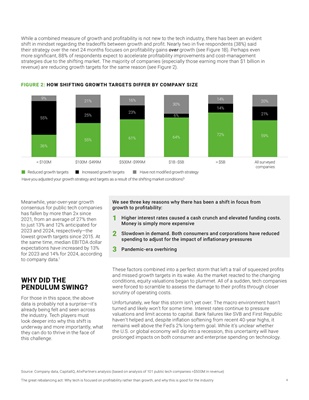
The great rebalancing act: Why tech is focused on profitability rather than growth, and why this is good for the industry 4
While a combined measure of growth and profitability is not new to the tech industry, there has been an evident
shift in mindset regarding the tradeoffs between growth and profit. Nearly two in five respondents (38%) said
their strategy over the next 24 months focuses on profitability gains over growth (see figure 1B). Perhaps even
more significant, 88% of respondents expect to accelerate profitability improvements and cost-management
strategies due to the shifting market. The majority of companies (especially those earning more than $1 billion in
revenue) are reducing growth targets for the same reason (see figure 2).
We see three key reasons why there has been a shift in focus from
growth to profitability:
Higher interest rates caused a cash crunch and elevated funding costs.
Money is simply more expensive
Slowdown in demand. Both consumers and corporations have reduced
spending to adjust for the impact of inflationary pressures
Pandemic-era overhiring
These factors combined into a perfect storm that left a trail of squeezed profits
and missed growth targets in its wake. As the market reacted to the changing
conditions, equity valuations began to plummet. All of a sudden, tech companies
were forced to scramble to assess the damage to their profits through closer
scrutiny of operating costs.
Unfortunately, we fear this storm isn't yet over. The macro environment hasn't
turned and likely won't for some time. Interest rates continue to pressure
valuations and limit access to capital. Bank failures like SVB and First Republic
haven't helped and, despite inflation softening from recent 40-year highs, it
remains well above the Fed's 2% long-term goal. While it's unclear whether
the U.S. or global economy will dip into a recession, this uncertainty will have
prolonged impacts on both consumer and enterprise spending on technology.
Have you adjusted your growth strategy and targets as a result of the shifting market conditions?
Reduced growth targets Increased growth targets Have not modified growth strategy
FIGURE 2: HOW SHIFTING GROWTH TARGETS DIFFER BY COMPANY SIZE
$100M -$499M
< $100M $500M -$999M $1B -$5B
21%
36%
55%
9%
55%
25%
61%
23%
16%
14%
64%
6%
72% 59%
21%
20%
30%
14%
> $5B All surveyed
companies
Meanwhile, year-over-year growth
consensus for public tech companies
has fallen by more than 2x since
2021, from an average of 27% then
to just 13% and 12% anticipated for
2023 and 2024, respectively-the
lowest growth targets since 2015. At
the same time, median EBITDA dollar
expectations have increased by 13%
for 2023 and 14% for 2024, according
to company data.1
WHY DID THE
PENDULUM SWING?
For those in this space, the above
data is probably not a surprise-it's
already being felt and seen across
the industry. Tech players must
look deeper into why this shift is
underway and more importantly, what
they can do to thrive in the face of
this challenge.
1
2
3
Source: Company data, CapitalIQ, AlixPartners analysis (based on analysis of 101 public tech companies >$500M in revenue)